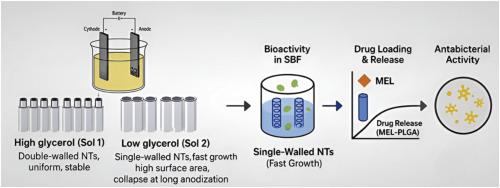Synthesis and tunable properties of double-walled and single-walled zirconia nanotubes: Enhancing bioactivity for bone and dental implants with controlled local delivery of antimicrobial peptides
IF 4.7
3区 材料科学
Q2 MATERIALS SCIENCE, MULTIDISCIPLINARY
引用次数: 0
Abstract
This study investigated zirconia (ZrO2) nanotubes (NTs) synthesized by anodization in electrolytes with different glycerol concentrations. High-glycerol solution (sol 1) produced double-walled NTs, whereas low-glycerol solution (sol 2) formed single-walled NTs at 60 V. Well-ordered NTs were developed within 0.5–1 h in both electrolytes, with sol 2 exhibiting faster growth and a higher initial surface area (166.00 m2/g at 1 h). Crystallographic analysis revealed mixed tetragonal and monoclinic phases, with sol 1 favoring the tetragonal phase and sol 2 favoring the monoclinic phase at extended anodization times. In simulated body fluid (SBF) tests, both NTs demonstrated strong apatite-forming ability over 28 days, achieving Ca:P ratios of 1.86 (sol 1, 3 h) and 1.94 (sol 2, 1–3 h). Notably, sol 2 promoted faster and more extensive apatite deposition compared with sol 1; however, prolonged anodization led to partial collapse of the NT structure, reducing accessible surface area. Based on bioactivity and stability, sol 2 NTs anodized for 1 h were selected for drug delivery studies using a melittin (MEL)–Poly (lactic-co-glycolic acid) (PLGA) system. Uncoated NTs released 50 % of MEL within 60 min, whereas PLGA-coated NTs provided sustained release and enhanced antibacterial activity against Staphylococcus aureus (S. aureus). The results highlight the potential of ZrO2 NTs as biomedical implant coatings, offering tunable morphology, bioactivity, and drug release properties for improved osseointegration and infection prevention.

双壁和单壁氧化锆纳米管的合成和可调性能:通过控制抗菌肽的局部递送来增强骨和牙种植体的生物活性
研究了在不同甘油浓度的电解液中阳极氧化合成氧化锆(ZrO2)纳米管。高甘油溶液(溶胶1)产生双壁纳米管,而低甘油溶液(溶胶2)在60 V下形成单壁纳米管。两种电解质在0.5-1 h内形成了有序的纳米管,其中溶胶2的生长速度更快,初始表面积更高(1 h时为166.00 m2/g)。晶体学分析显示,在延长阳极氧化时间时,溶胶1倾向于四方相,溶胶2倾向于单斜相。在模拟体液(SBF)测试中,两种nt在28天内都表现出很强的磷灰石形成能力,Ca:P比值分别为1.86(土壤1,3 h)和1.94(土壤2,1 - 3 h)。值得注意的是,与溶胶1相比,溶胶2促进磷灰石沉积的速度更快、范围更广;然而,长时间的阳极氧化导致NT结构的部分坍塌,减少了可接近的表面积。基于生物活性和稳定性,选择溶胶2 NTs阳极氧化1 h,使用蜂毒素(MEL) -聚乳酸-羟基乙酸(PLGA)体系进行给药研究。未包被的NTs在60分钟内释放50%的MEL,而plga包被的NTs具有持续释放和增强对金黄色葡萄球菌(S. aureus)的抗菌活性。研究结果强调了ZrO2 NTs作为生物医学种植体涂层的潜力,它具有可调节的形态、生物活性和药物释放特性,可以改善骨整合和预防感染。
本文章由计算机程序翻译,如有差异,请以英文原文为准。
求助全文
约1分钟内获得全文
求助全文
来源期刊

Materials Chemistry and Physics
工程技术-材料科学:综合
CiteScore
8.70
自引率
4.30%
发文量
1515
审稿时长
69 days
期刊介绍:
Materials Chemistry and Physics is devoted to short communications, full-length research papers and feature articles on interrelationships among structure, properties, processing and performance of materials. The Editors welcome manuscripts on thin films, surface and interface science, materials degradation and reliability, metallurgy, semiconductors and optoelectronic materials, fine ceramics, magnetics, superconductors, specialty polymers, nano-materials and composite materials.
 求助内容:
求助内容: 应助结果提醒方式:
应助结果提醒方式:


